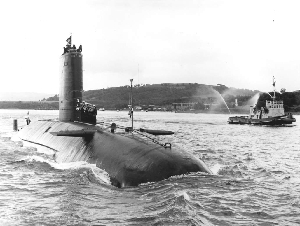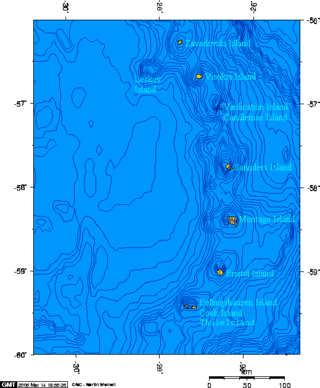Related Research Articles

The Falklands War was a ten-week undeclared war between Argentina and the United Kingdom in 1982 over two British dependent territories in the South Atlantic: the Falkland Islands and its territorial dependency, South Georgia and the South Sandwich Islands. The conflict began on 2 April, when Argentina invaded and occupied the Falkland Islands, followed by the invasion of South Georgia the next day. On 5 April, the British government dispatched a naval task force to engage the Argentine Navy and Air Force before making an amphibious assault on the islands. The conflict lasted 74 days and ended with an Argentine surrender on 14 June, returning the islands to British control. In total, 649 Argentine military personnel, 255 British military personnel, and three Falkland Islanders were killed during the hostilities.

HMS Conqueror was a British Churchill-class nuclear-powered fleet submarine which served in the Royal Navy from 1971 to 1990. She was the third submarine of her class, following the earlier Churchill and Courageous, that were all designed to face the Soviet threat at sea. She was built by Cammell Laird at Birkenhead.
This is a list of the naval forces from the United Kingdom that took part in the Falklands War, often referred to as "the Task Force" in the context of the war. For a list of naval forces from Argentina, see Argentine naval forces in the Falklands War.

Operation Keyhole was a British special operation to recapture Thule Island in the South Sandwich Islands during the Falklands War. The operation took place from 19 to 20 June 1982.

HMS Cardiff was a British Type 42 destroyer and the third ship of the Royal Navy to be named in honour of the Welsh capital city of Cardiff.

HMS Brilliant was a Type 22 frigate of the Royal Navy.

The Armilla patrol was the name of the Royal Navy's permanent presence in the Persian Gulf during the 1980s and 1990s.

RFA Olmeda (A124) was an Ol-class "fast fleet tanker" of the Royal Fleet Auxiliary. The ship was renamed from Oleander after two years in operation.

HMS Yarmouth was the first modified Type 12 frigate of the Rothesay class to enter service with the Royal Navy.

Admiral of the Fleet John David Elliott Fieldhouse, Baron Fieldhouse, was a Royal Navy officer. He commanded five submarines and a frigate before achieving higher command from the 1970s. Following the invasion of the Falkland Islands by Argentine forces in April 1982, Fieldhouse was appointed Commander of the Task Force given responsibility for "Operation Corporate", the mission to recover the Falkland Islands. The campaign ended in the surrender of Argentine forces in June 1982. He became First Sea Lord and Chief of Naval Staff in December that year and, in that role, persuaded the British Government to fund the replacement of ships lost in the Falklands War. He went on to be Chief of the Defence Staff from 1985 until his retirement in 1988.
These are some of the key weapons of the Falklands War used by both sides.

Operation Paraquet was the code name for the British military operation to recapture the island of South Georgia from Argentine military control in April 1982 at the start of the Falklands War.

HMS Endurance was a Royal Navy ice patrol vessel that served from 1967 to 1991. She came to public notice when she was involved in the Falklands War of 1982. The final surrender of the war, in the South Sandwich Islands, took place aboard Endurance.
There were many events leading to the 1982 Falklands War between the United Kingdom and Argentina over possession of the Falkland Islands and South Georgia.

The aftermath of the 1982 Falklands War between the United Kingdom and Argentina affected world geopolitics, the local political culture in Argentina and the UK, military thought, medical treatment, and the lives of those who were directly involved in the war.

The Battle of San Carlos was a battle between aircraft and ships that lasted from 21 to 25 May 1982 during the British landings on the shores of San Carlos Water in the 1982 Falklands War. Low-flying land-based Argentine jet aircraft made repeated attacks on ships of the British Task Force.
The 1981 Defence White Paper was a major review of the United Kingdom's defence policy brought about by the Conservative government under the Prime Minister Margaret Thatcher. The main author was the then Secretary of State for Defence, John Nott. The aim of the review was to reduce expenditure during the early 1980s recession and to focus on supporting NATO rather than out of area operations. It was ultimately judged however to have been extremely detrimental to the Defence of the Realm, being among other things widely considered to have been one of the contributing factors that led to the outbreak of the Falklands War.
Christopher Louis Wreford-Brown DSO RN is a retired British Royal Navy officer.
Rear-Admiral Hugh Maxwell Balfour was a Scottish Royal Navy officer.

Exercise Spring Train was an annual Royal Navy-led NATO maritime exercise conducted in the Eastern Atlantic. It is most notable for the 1982 exercise which involved seven warships that were subsequently sent to the South Atlantic after the Argentine invasion of the Falkland Islands. Because the vessels involved already had full crews and were able to crossdeck supplies from other ships in the exercise the British response was more rapid than would have otherwise been possible. Two of the vessels involved in the exercise, the Type 42 destroyers Sheffield and Coventry, were sunk during the war. There has been speculation that some of the ships sent to the Falklands from Exercise Spring Train were carrying tactical nuclear weapons, which were routinely carried when on NATO deployments. The 1983 edition of the exercise was criticised by the Spanish and Soviet government who considered it provocative.
References
- 1 2 Ben Fenton (1 June 2005) "Secret Falklands task force revealed", Daily Telegraph
- ↑ BBC News: Secret Falklands fleet revealed
- ↑ Trevor Harris (2017). 30 Years After: Issues and Representations of the Falklands War. Routledge. p. 152. ISBN 9781138703285.
- ↑ "Hugh Balfour". The Guardian . 2 August 1999. Retrieved 27 March 2016.